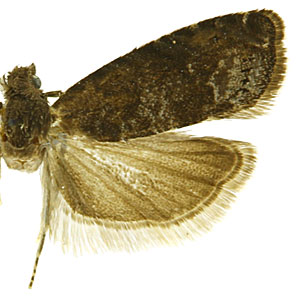Adult Recognition

FWL: 4.0-7.5 mm
Forewings are grayish brown with indistinct silvery-gray markings on the dorsum and around the poorly-defined ocellus. Hindwings are brown. Male genitalia are characterized by a thornlike projection off the ventral margin of the valva. Female genitalia are characterized by a rounded sterigma, an irregular sclerite in the ductus bursae, and two long, curved, thornlike signa in the corpus bursae.
Adults are similar to other species of Grapholita, including Grapholita molesta and Grapholita tenebrosana; a genitalic dissection may be necessary to confirm species identity, especially if individuals are recovered from sticky traps. In G. molesta, males lack the thornlike projection off the ventral margin of the valva and the female sterigma is laterally elongate with small posterolateral projections. In G. tenebrosana, the male valva is more elongate with the anal angle sharply pronounced and the female sterigma is large with triangular lateral lobes.
Pheromone traps using "Funemone" lures are commonly used to trap male G. funebrana. Alford (1978) provided trapping data for "Funemone" traps operating in England over the course of three years. Non-target tortricids attracted to the "Funemone" pheromone include: Cnephasia stephensiana, Cnephasia sp., Celypha rufana, Hedya nubiferana, Pammene argyrana, Pammene fasciana, and Grapholita tenebrosana. As the lure is not species-specific, it will also attract other species of Grapholita, including Grapholita molesta.
Larval Morphology

Late instar larvae are approximately 9-12 mm in length with a bright reddish-pink abdomen. The head is dark brown and the prothoracic shield is yellowish brown. The anal shield is light brown with dark mottling. An anal comb is present with 4-10 small teeth. Early instars are whitish with a black head and prothoracic shield.
Larvae may appear similar to those of many other species of Grapholita and Cydia. Cydia pomonella larvae can be separated from G. funebrana by the absence of an anal fork. Other species of Grapholita cannot be reliably separated from G. funebrana based solely on larval morphology. Chen and Dorn (2009) provide a molecular assay to distinguish G. funebrana larvae from similar species using a polymerase chain reaction-restriction fragment length polymorphism (PCR-RFLP) analysis.
Biology

Grapholita funebrana completes 1-3 generations per year; two generations are most common over most of its range. Adults are present from late May to September.
First generation females lay eggs singly on fruitlets. Second generation females lay eggs near the base of maturing fruit. Larvae tunnel into the fruit and feed inside. Last instar larvae bore out of the fruit and overwinter in a cocoon spun on tree bark or in the soil. Pupation occurs the following spring. Larvae of the second generation cause the most damage to fruits such as plum that mature in mid- to late summer.
Host plants
Grapholita funebrana is one of the most important lepidopteran pests of fruit in Europe. Larvae can cause significant damage to apricot, cherry, peach, plum, and other Prunus species.
| Family | Genus/species | Common name |
| Rosaceae | Prunus armeniaca L. | apricot |
| Rosaceae | Prunus avium (L.) L. | sweet cherry |
| Rosaceae | Prunus domestica L. | European plum |
| Rosaceae | Prunus domestica L. var. insititia (L.) Fiori & Paoletti | European plum |
| Rosaceae | Prunus fruticosa Pall. | European dwarf cherry |
| Rosaceae | Prunus japonica Thunb. | Japanese bush cherry |
| Rosaceae | Prunus L. | |
| Rosaceae | Prunus maximowiczii Rupr. | Korean cherry |
| Rosaceae | Prunus persica (L.) Batsch | peach |
| Rosaceae | Prunus spinosa L. | blackthorn |
| Rosaceae | Pyrus ussuriensis Maxim. | |
| Rosaceae | Rosa davurica Pall. | Amur rose |
Distribution

A native of Europe, Grapholita funebrana has spread to most other fruit-growing regions of the Palearctic. It is currently present from Europe and northern Africa across Asia Minor and Central Asia to China, Korea, and Japan.
References

Alford, D. V. 1978. Observations on the specificity of pheromone-baited traps for Cydia funebrana (Treitschke) (Lepidoptera: Tortricidae). Bulletin of Entomological Research. 68: 97-103.
Bradley, J. D., W. G. Tremewan and A. Smith. 1979. British Tortricoid Moths - Tortricidae: Olethreutinae. The Ray Society, London, England. 336 pp.
Chen, M. H. and S. Dorn. 2009. Reliable and efficient discrimination of four internal fruit-feeding Cydia and Grapholita species (Lepidoptera: Tortricidae) by polymerase chain reaction-restriction fragment length polymorphism. Journal of Economic Entomology. 102: 2209-2216.
Dickler, E. 1991. Tortricid pests of pome and stone fruits, Eurasian species, pp. 435-452. In L. P. S. van der Geest and H. H. Evenhius [eds.], Tortricid Pests: Their Biology, Natural Enemies, and Control. World Crop Pests, Vol. 5. Elsevier, Amsterdam.
Komai, F. 1999. A taxonomic review of the genus Grapholita and allied genera (Lepidoptera: Tortricidae) in the Palaearctic region. Entomologica Scandinavica Supplement 55. 226 pp.
Meijerman, L. and S. A. Ulenberg. 2000. Arthropods of Economic Importance: Eurasian Tortricidae. Arthropods of Economic Importance series. ETI/ZMA.
Razowski, J. 2003. Tortricidae of Europe, Vol. 2, Olethreutinae. Frantisek Slamka, Slovakia. 301 pp.






